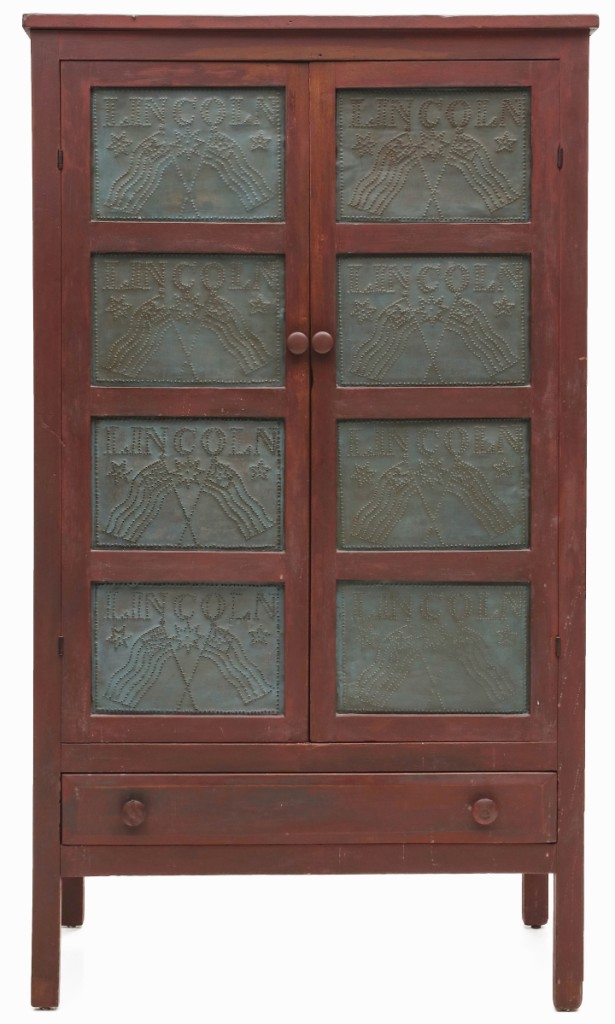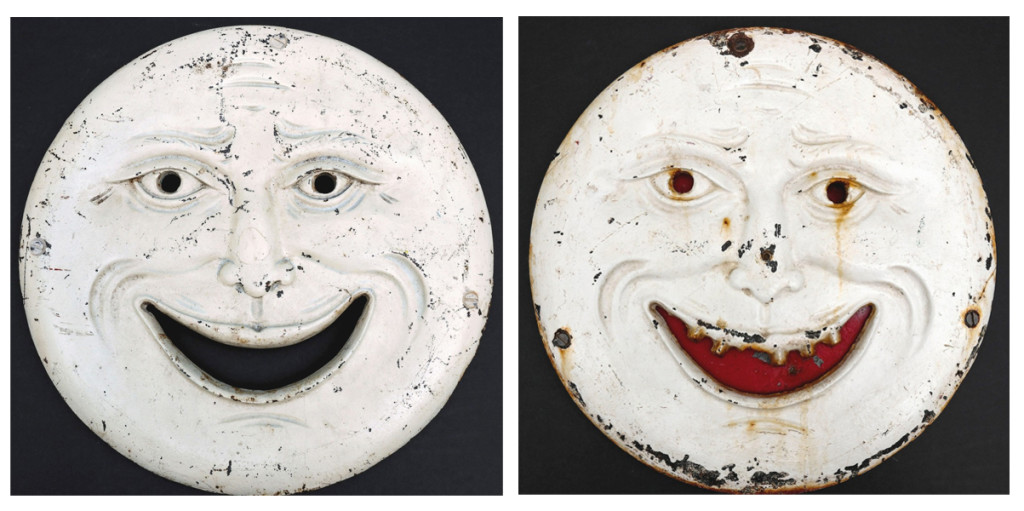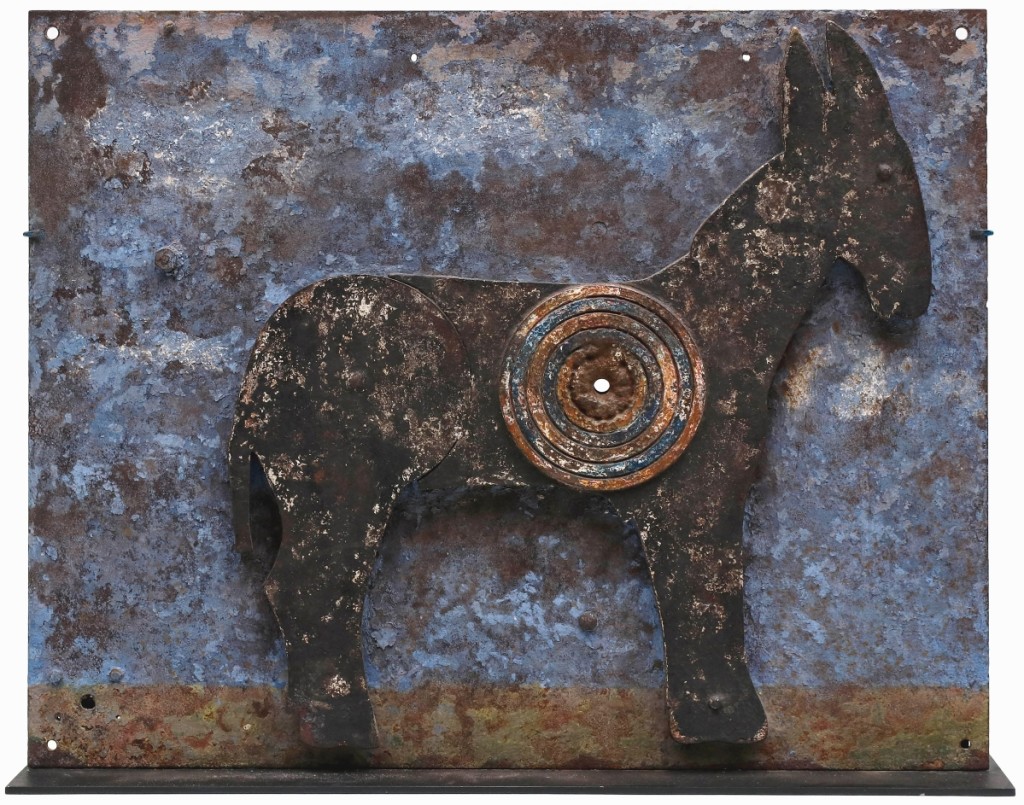Review by Greg Smith, Photos Courtesy Dirk Soulis Auctioneers
LONE JACK, MO. – In the span of seven days, auctioneer Dirk Soulis released 583 lots in two parts from both the Americana collection of Jerry and Cathy Mueller and the most renowned collection of iron shooting gallery targets ever assembled from Richard and Valerie Tucker. The sales would combine for more than $1 million, inclusive of buyer’s premium.
The auctioneer dubbed the two sales his own little “Americana Week in Missouri,” and just like the real deal in New York, Soulis said he had buyers driving, in some cases, 14 hours to the preview and attend the auction. Given the amount of iron on offer, it was likely cheaper than shipping.
When we last spoke with Soulis in August, the auctioneer said he had introduced a novel approach to bidding: the drive-in auction. Though bidders could sit in the seats under a large canopy tent, they could also drive their car up to the tent’s perimeter and tune into an FM station to hear the auctioneer and bid either online or by raising their paddle from the window.
“I got 15 fly swatters and folded the bid cards onto them,” Soulis said. “Those people in the cars were easier to see than the people sitting in the front row. They were as close as some of the people in the chairs.”
The Mueller Collection

Auctioneer Dirk Soulis said he knew of only three other presidential pie safes, two for Andrew Jackson and one for George Washington. This example, with the tins featuring the letters “Lincoln” above crossed flags and floating stars, is the fourth. It sold for $38,420, the highest result of any in the Mueller collection.
The first sale of Americana material, from the collection of Jerry and Cathy Mueller, Sioux City, Iowa, launched 258 lots onto the market on September 19 and came away with a total of $451,094. Only one lot passed.
Soulis said the couple collected over a period of 30 years from both auctions and dealers and were avid recyclers as they traded up for better examples.
“I summarized it as small but mighty,” Soulis said. “There wasn’t a lot of fluff. To get a sale like that, we usually have to sell one or two other auctions of things that aren’t so noteworthy. The collection was refined, all the examples were pretty darn good, people recognized that.”
The offering was led by a $38,420 result for a red-painted pie safe with 16 punched tins lettered “Lincoln” above crossed flags and floating stars.
Soulis wrote that only four presidential pie safes are known, two for Andrew Jackson, one for George Washington and this example, which was purchased by a collector at the Indianapolis Crutcher Show in the 1970s. It was sold by the consignor – and bought by the Muellers- in 2017 at an Ohio auction house for $22,800, a 68 percent increase in value in three years. The buyer was a New York City collector who negotiated terms with Soulis that the pie safe had to be delivered with a meal of Kansas City barbecue, which the auctioneer sent along with the shipper.

Leading all weathervanes was this running stag attributed to J.W. Fiske, which leapt to quadruple estimate for $21,470. Seven phone bidders competed on it and they all lost.
Another pie safe in the sale, originally purchased from Olde Hope Antiques, was a Shenandoah Valley example in old green-blue paint that took $7,910. Each door and the two side panels featured three tins each, punched with heart and tulip patterns.
The Muellers assembled a weathervane collection through their associated dealers, led by a full-bodied copper running stag attributed to J.W. Fiske, which sold for $21,470, above a $5,000 estimate. It had seven phone bidders on it, though it sold online. Perhaps the largest surprises for Soulis were the weathervanes on lightning rods, which handily outperformed their low estimates. A figural ram took $12,430, a sheet metal rooster brought $7,345 and a W.C. Shinn beaver-form vane took $7,345. In Weathervanes of New England, Knoblock and Wemmer wrote on lightning rod weathervanes, “Nearly all weathervanes of this type were manufactured in the midwestern states such as Iowa, Illinois and Wisconsin, where lightning rod companies, as well as agricultural fixture and implement manufacturing companies, were headquartered.” The authors also noted that lightning rod vanes had largely been ignored by collectors and do not command the same prices. Perhaps there has been a change in the wind.
“The lightning rods did well,” Soulis said. “A lot of folks, myself included, thought they were looking at some basic weathervanes in the $300/500 range, but when the rubber hit the road, it became abundantly clear that wasn’t the case. We had a lot of in-person action on the weathervanes. We had one gentleman in a car on them, he was a strong buyer, and then two more under the tent.”

Attributed to Samuel Robb, this tobacconist figure on pedestal sold for $13,560. She measured 69 inches high.
The Muellers amassed a formidable collection of trade signs, which included 15 barber poles, 11 optometrist signs, ten watch signs, four druggist signs and three boot makers signs. Leading them all at $12,430 was an iron and zinc optician’s trade sign of eyeglass form with a banner beneath for L.D. Cutler, who worked in Windsor Locks, Conn., in the first half of the Twentieth Century. The barber poles stood tallest with a $5,428 result in a wall-mounted example in bright paint with silver stars. Highest among the watch signs was a two-sided example of a pocket watch, 36 inches high, for Harrington Jeweler, a store once located at 107 Washington Street in Kirksville, Mo. The sign took $4,400.
Selling to an online buyer was the only tobacconist trade figure in the sale, a pine figure of a standing Native American attributed to Samuel Robb that brought $13,560. On a black, wheeled pedestal, the figure rose 69 inches high.
Soulis said that collectors were strong buyers in the sale. “A lot went to collectors. I saw the trade roll their eyes and toss the bid cards to the side more than once.”
The Richard and Valerie Tucker Collection

The top lot of the Tucker collection was this light-up clown target that would blink through his eyes. At 26 inches tall, the clown would have been a centerpiece of a Mangels shooting gallery. It featured old park paint and sold for $35,200 to a Beverly Hills buyer. The Tuckers are aware of no other example and Soulis believes the price establishes this piece as the auction record for any single shooting gallery target.
Dirk Soulis remembers reading Richard and Valerie Tucker’s ads in Antique Trader over three decades ago, even calling them up to sell them a thing or two back then. They would come into contact a few times in the decades since, but were reunited in the months before the pandemic as the couple was downsizing and looked to move along their renowned collection of iron shooting gallery targets that they had amassed and publicized.
It was no ordinary collection.
The Tuckers are an authority on iron shooting gallery targets and most things arcade, having published the lone and definitive 2014 title on the subject, Step Right Up! Classic American Target and Arcade Forms, in which nearly all of the lots in the sale were illustrated.
The Tuckers made their way into the folk art world by means of collecting Modern art. When the prices rose so high, the couple made the decision to sell the works they had and fund an equally satisfying and more numerous collection in like-minded and visually powerful material, a journey that could fill a home with aesthetic joy.
Aarne Anton of American Primitive Gallery, who wrote the foreword to the Tuckers’ book, called it the greatest shooting gallery target collection in the world. Through his base-making business, Anton mounted and handled many of the pieces in the sale. He also sold numerous works into the collection and helped the couple upgrade with finer examples.

At 53½ inches tall, Shorty the cowboy was produced by Mangels and came with a pockmarked surface. He sold as the second highest lot in the sale at $33,000.
“A sale like the Tuckers’, it has a point of view – an educated eye,” Anton said. “They were the authorities on these things and they sought out anyone that knew about these makers and the era. Watching the sale was a learning experience. Richard and Valerie had spent so much time digging and researching for the catalogs and the history of the different makers. They’re one of the few people who know from looking at a target where it was from and the period it was made. Through their book, which is really the best source, we know where the centers of target-making were.”
When he first had an inkling that the Tuckers were interested in selling their collection, Dirk Soulis had just one thing to say: “Helen Keller could sell that collection. All the work is done – anyone could.”
What would follow would be the single largest release of shooting gallery targets onto the market at any one point.
Soulis noted that bidders with an interest in arcade forms flocked to the sale, but prices were largely buoyed by folk art collectors.

The Tuckers found this iron crocodile target, the only example known from Mangels, in a New Hampshire barn. He pulled the third highest result of the sale at $23,600. The target measured 33 inches long with applied bull’s-eye for an eye and the original iron gong to the back.
“I proposed to the Tuckers that there are three main categories of buyers,” he said, ” of course there were the shooting gallery target collectors who might be interested in the rare or scholarly examples, but I’m not sure that the stronger bidding wasn’t on behalf of the folk art market. Then there were general iron buyers.”
Soulis described the Tuckers as hunters who scoured the Midwest from Texas on up to Nebraska and also New Hampshire, where they summered. “They would go searching for things and they would rent cars. They didn’t want to take their car, they knew they were going to load the suspension down because they had so much cast iron in the trunk.”
The Tuckers’ auction would go on to produce $566,122 in total sales.
Leading the way was the only known “Clown” light-up gallery target produced by Coney Island’s William F. Mangels, which sold for $35,200 to a Beverly Hills celebrity. Soulis believes it to be an auction record for any single shooting gallery target. In original old park paint, the clown is believed to be the only example known. Its size at 26 inches high made it the centerpiece of the gallery that would anchor the display. It was illustrated not only in the Tuckers’ book, but also Maresca and Ricco’s American Vernacular.

This whippet dog was the highest result from Kansas maker C.W. Parker at $19,210. He would typically be seen in pursuit of a rabbit target. It featured its original paint and measured 26¾ inches long.
Mangels was among the East’s finest purveyors of amusement inventions and rides, beginning his career in Coney Island at age 16 as a new immigrant from Germany. Three years later, he started his own machine shop where he made cast iron targets of alluring subject and form that were considered a great improvement from their predecessors. Mangels’ business would considerably expand, and according to the Coney Island History Project, his shop could repair any ride on Coney Island. He would go on to produce a number of famous carousels on Coney Island, including some he partnered with carousel carver MC Illions on. Among any maker, Mangels approached his craft somewhere between the intersection of commerce, art and culture. He would go on to found the American Museum of Public Recreation to catalog the objects and ways in which Americans spent their leisure time, though it closed in 1955.
The sale’s second and third top lots were also by Mangels. Known as “Shorty,” the 53-inch cowboy gunfighter with a target on his heart and through his hat went out at $33,000.
Rising above the $9,000 high estimate to sell for $23,600 was another example of a target that is the only one known, a Mangels crocodile that the Tuckers fished out of a barn.
“While in New Hampshire, the Tuckers got a call one day about a guy with a barn that had some stuff in it,” Soulis said. “Among it all was this crocodile. The circumstance of that find is something else, that they were shooting gallery collectors and they happened upon probably the only barn in New Hampshire with a shooting gallery target in it. And it was this one. They have some great stories about their times collecting.”

Which moon is better: the example with or without teeth? The answer is without, as the only known H.C. Evans “Man In The Moon” target sold for $17,700. Evans’ competitor Emil Hoffmann would reproduce the form with teeth, of which only a few are known, and it would bring $8,850.
Anton related that many of the subjects of these targets related to their era.
“People can get bent out of shape at how politically incorrect some of these were, but think of them as cartoons,” he said. “Some of the targets related to people’s frustrations. When you go back to World War II, there were Hitler targets or Japanese targets. All kinds of stereotypes. There were rows of battleships or soldiers in arcades, too.”
But ultimately, Anton noted, and relating back to Mangels’ museum, these pieces were for amusement and leisure.
He said, “Part of the attraction for kids was shooting the guns, but it’s all imagination, mixing reality and game playing. Like Elmer Fudd going after Buggs Bunny. It’s a precursor to video games, the now billion-dollar industry. When people went to the arcade, it wasn’t a still thing, everything was moving – all these rows of targets would be moving on chains, the wheels would be spinning and the lights would be flashing.”
Most targets were animals or figural archetypes, but there were some that appealed to the issues of the age. One that related directly to a cartoon figure was J.T. Dickman’s “Baby Snookums,” which derived its form from George McManus’ 1907 comic strip The Newlyweds. It sold for $3,776.

Not many targets in the sale featured backdrops, but the one behind this mule gave it the feel of a painting. H.C. Evans called it the “Evans’ Kicking Mule” and when shot, the mule would swing its legs up in a kicking motion. It brought $7,080.
Anton said, “If you think about it, it’s outrageous – how politically incorrect can you get to shoot at a baby crying. But it was aimed at the frustration of parents: the baby is crying and they can’t get to sleep.”
The same idea applies to the “Howling Cat,” found in the catalogs of both Dickman and possibly H.W. Terpening. With white and red paint, it sold for $4,484. “If you had an alley cat in heat outside your window, they could howl all night,” Anton said. “At an arcade, you would shoot them in the mouth to shut them up.”
In the Midwest, there was no rival to C.W. Parker, who created shooting galleries and carousels out of Kansas. He earned the nickname of the “Amusement King,” and some of his carousels are still in operation today.
Parker’s finest contributions to the sale came in the form of a whippet dog and an owl. The whippet in original red paint was produced pre-1910 when Parker worked out of Abilene, Kan., and sold for $19,210 on a $6,000 high estimate. The owl, at $16,500, was finely modeled with details not found in other targets. It was also produced in Abilene and a successful strike at the bull’s-eye through the owl’s chest would activate the flapping of the wings.

Earning the second highest price of any C.W. Parker target was this owl whose wings would flap when a bull’s-eye was struck. It was a fine piece with exceptional feathered detail and sold for $16,500.
Apart from figural targets, rotating examples produced some fine results, including a five-pointed star by Mangels that sold at $7,080. The star featured a perimeter of clay pipes that would burst when hit. The Tuckers had these cast in plaster of Paris from an original Mangels iron pipe. Just behind at $5,500 was another Mangels example – a real stunner – of a circular iron disc in yellow with a red spiral faintly seen circling towards the center, the perimeter featuring 12 lollipops.
The sale also offered iron in other forms. Among them was a bench held up on each side with matching swans, their long swooping neck supporting the backrest. It was purportedly inspired by Queen Victoria’s swans on the Thames and it sold for $7,080. A cast iron tobacconist trade figure of a Native American brought the same price, her tobacco leaf headdress and the leaves held in her hand were of bronze.
Among sprinklers rose a rare male cardinal on twig that was 12 inches long and brought $5,900. A bullfrog on a beach ball dating around the second quarter of the Twentieth Century featured bright paint and sold for $2,832.
Soulis said that some bidders came to both sales, while others were happy to bid one absentee and the other in person or both by absentee. He said interest was dispersed across America.
Americana Week in Missouri scored a bull’s-eye.
For additional information, www.dirksoulisauctions.com or 816-697-3830.






















































